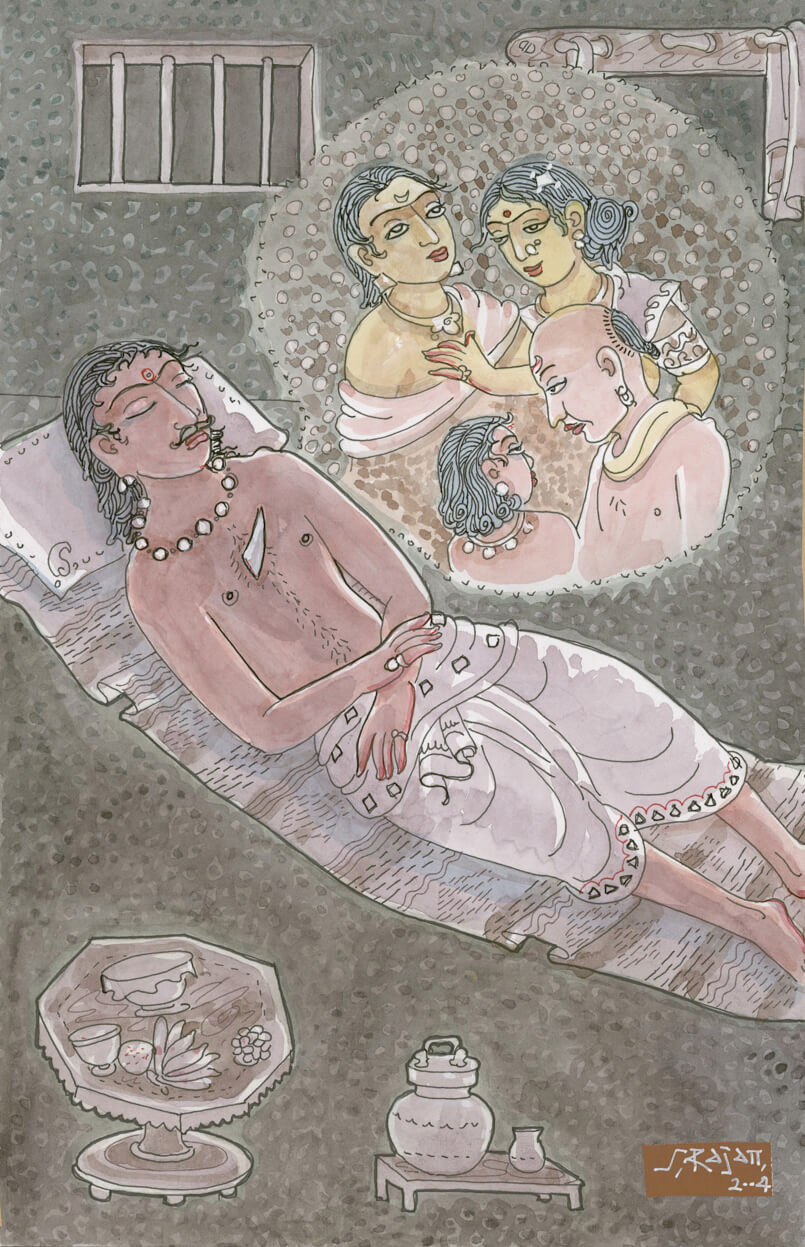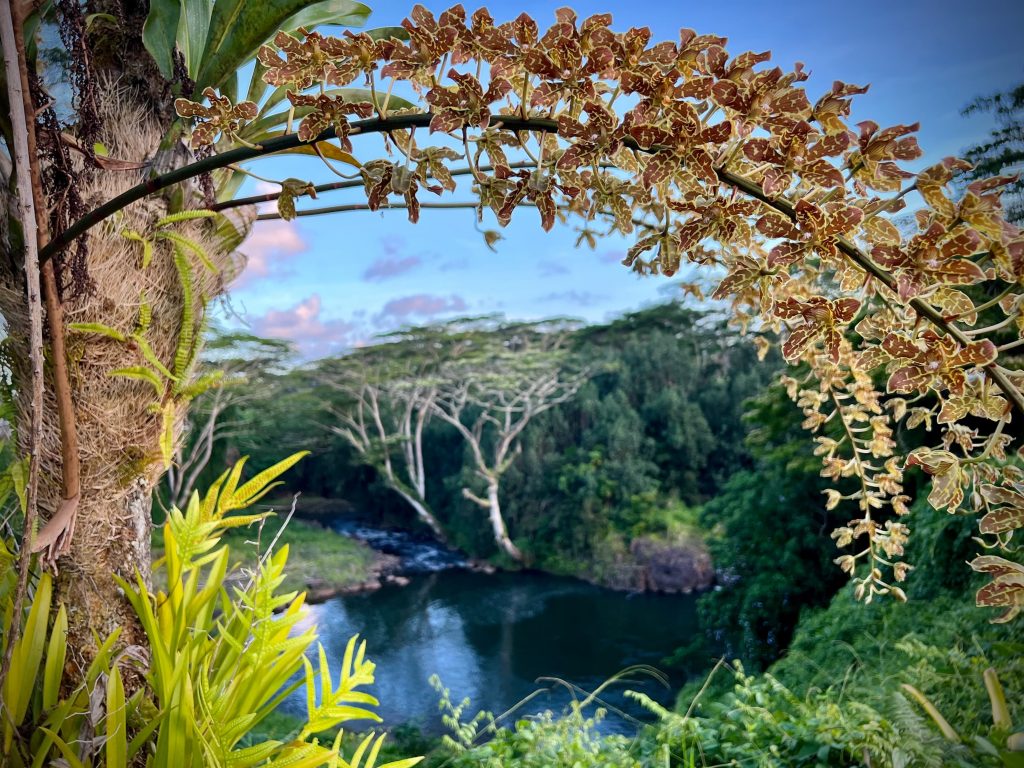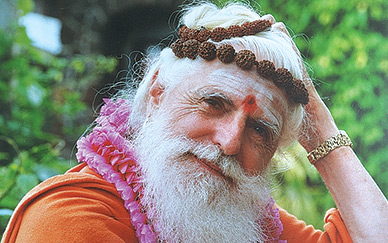Monastic Family Visit
Building Iraivan Temple With Rudrakshas
Aum Namah Sivaya
For many years now, the shishya of our local Wailua Mission have been working tirelessly to harvest, clean, drill, oil and string Siva's most divine seed. These five-faced beads represent the five divine functions of Lord Siva by which we and the whole Universe evolve: Creation, Preservation, Dissolution, Ignorance and Illumination. The rudrakshas are used for malas, bracelets, earrings and more. With this wonderful effort has come an abundance of rudraksha sales in our Mini Mela store, accounting for a large percentage of Iraivan Temple's monthly donations. Aum.
Some Recipes for a Tasty Lunch

Jai Ganesha!
Today we take you through some savory classic dishes. Our monks rotate through cooking meals, so each day has a slightly different flavour. You'll find several online review for the monastery that state something like "The view was gorgeous, but whatever amazing-smelling food they were cooking prompted us to leave right away to get lunch." For there's nothing quite like the Indian practice of tempering spices in oil, which infused the whole dish with flavour and the whole atmosphere with mouth-watering aromas.
Lotuses for Siva

The lotus is of course legendary, for its beauty and rarity, for its water-repelling leaves and more. Lotuses are everywhere in Iraivan.
Years ago we had a large pond with hundreds of plants and blossoms, but along came the tropical tilapia fish and ate them all (people eat the roots, too).
We are trying again and today four different kinds came to the garden, to be planted soon, this time in more protected areas.
The Human Aura – Part 2
Satguru Bodhinatha Veylanswami gives his weekly upadesha in Kadavul Temple at Kauai's Hindu Monastery in Hawaii. It is part of a series of talks elaborating on the inspired teachings of Sivaya Subramuniyaswami as found in his book Merging With Siva. Here, Satguru discusses "The Human Aura," based on a series of talks given in 1960.
Tirukural – Chapter 89

Chapter 89: Internal Enmity

Verse 885
A man who is miserable is sleeping and dreaming of his relatives, whom he hates and despises. The sleeping man's animosity will kill him, like the dagger that has penetrated his chest.
You can access the entire text, in Tamil and English here:
Weaver's Wisdom
Verse 881
Even shade and water are unpleasant if they breed disease.
So, too, may relatives be unpleasant if they cause harm.
Verse 882
Fear not the foe who is like a drawn sword;
rather fear the friendship of an enemy who poses as kin.
Verse 883
Dread hatred from within and defend yourself against it.
In calamitous times it will cut deeper than a potter's knife.
Verse 884
Hidden hatreds may lurk only in the mind,
yet among kin they can manifest many miseries.
Verse 885
Hate hidden in a kinsman's heart will cause
many miseries, and more--it will kill a man.
Verse 886
When hatred arises, dissension destroys unity,
and men fall inescapably toward ever-ready death.
Verse 887
A house that harbors hatred will never be a united whole,
though, like a vessel and its lid, it may appear to be one.
Verse 888
As iron is worn away by frequent filing,
a family's strength is eroded by incessant inner frictions.
Verse 889
Internal dissension may seem as small as a split sesame seed,
yet there is enough power in it to destroy.
Verse 890
Living with those who cannot dwell in harmony
is like living in a hut with a deadly cobra.
Consistency

A gramatophyllum orchid arches over the monastery pond, called Nani Kaua in Hawaiian. "There is an art which you can learn which will make all of your decisions easier. It is the art of being constant. Consistency wins. Consistency is one of the most important qualities of a devotee. It is only through consistency in your daily life that you gain the awareness which enables you to cognize the experiences of life, taking from them their real lessons. It is only through consistency that you can avoid many of the boulders that lie in your way on the classical yoga path to enlightenment. Practice the art of being constant, and you will unfold your destiny, discover what you were born to do and learn how to accomplish it in this life. For in that security you will awaken and fulfill your destiny and realize the Self. Thus having your feet planted firmly on the ground, your consciousness can dwell freely in the spirit born of Self Realization. Study your approach to life today as you practice this exercise. Take some of the experiences from your subconscious state of mind. Add them up and see how well your life balances out. Visualize a scale before you. Put the total of the experiences understood and the lessons derived from them on one side. Put on the other side of the scale the total number of experiences that you do not fully understand and from which you can still reap lessons. See how they balance. If they balance evenly, you are well on your way to becoming steadfast and constant. If they overbalance on the reactionary side, you are on the right track because you now have the power to balance your scale—your subconscious. If they overbalance on the understanding side, you should consider dedicating your life to the service of others. Sit quietly with your eyes closed. Look deep within and trace back to the peak experiences that have happened through your life from your earliest days. Quickly fan through the pages of your life and pinpoint each climax, and know that that climax was the sum total of many experiences, forming one great experience out of which one great lesson of life was born. ¶Take the experiences that you are not quite sure of—all the ones that you cannot form into a solid stone of understanding. Take those experiences and resolve to trace down each intuitively. Don’t analyze. Just look at the sum total of the experiences, and after awhile you will get your clarification in a flash of intuition. This will be of great benefit to you. The great lessons that those experiences offer will become apparent as you progress in your practice of concentration. Do this, and you will do much for yourself." - Gurudeva
New Garden Area
Aloha,
On this glorious day we are happy to announce that you are the first to know about two new areas on the monastery grounds! Thanks to a super huge excavator and our talented operator Dennis Wong, we uncovered two areas that until now contained items too large for the Monastery's machinery to handle. The first area is our organic waste depot where we deposit palm fronds and other organic matters from our landscaping. The area was becoming a little too full to be used properly. The second area is the space around Chellappaswami's granite statue at the top on the Path of the Saiva Satgurus. It was inhabited by some dead (but still fighting) banyan trees. Now we can look forward to the beautiful gardens that will be placed in their absence!
Aum Namah Sivaya!
Satguru Visits the Hindu Temple of St. Louis
The highlight of Satguru's recent trip the mainland was his attendance of the kumbha abhishakam at the Hindu Temple of St. Louis, which was built 36 years ago by Ganapati Sthapathi and Selvanathan Sthapathi. While there Satguru also gave two talks which were well received by attendees.
Here is the description of a Kumbha Abhishekam from the temple's website:
A Temple is a home of the Divine, meant for collective spiritual benefit and upliftment. The omnipotence of the supreme is manifested into Idols by Mantra Sakti at the time of consecration (PrathiSthapana) through a precise process ordained by the scriptures called Agamas, thereby making the Idols into Deities.
Kumbhabhishekam is derived from the Sanskrit words Kumbha (meaning metal or earthern vessel) and Abhishekam (sprinkling of holy water). Kumbhabhishekam literally means pouring of sacred water (from holy rivers or ritually purified) from the vessels over the Vigrahas (Deities) and the temple Gopurams (towers). Proir to this, the divine energy and spirit are invoked through religious rituals and homas, and transferred to the kumbhas containing the holy water.
At the start of Maha Kumbhabhishekam, the divine power of the main Deities (Moola Vigrahas) is temporarily transferred by the priests, following procedures of Agama, into holy water (Mantra Jalam) collected in Kalashas (Pots). These Kalashas are initially brought into a makeshift temple called Balalayam. Between May 11th and 15th, 2022, the Kalashas are relocated into Temples Yagashala, where offerings are made into the holy fire, and daily worship, rites, and other special ceremonies are undertaken. Until the final stages of Maha Kumbhabhishekam, the Deities are worshipped in the Kalashas. Upon completion of Temple renovations and replacement of Ashta Bandhana (to secure Idols to peetams), the divine power in the Kalashas is transferred back to the Moola Vigrahas by pouring the Mantra Jalam (holy water preserved in Kalashas) on Temple Vimanams and Gopurams, while chanting elaborate mantras. This process is called Maha Samprokshana and Ashtabandhana Jeernodharana - together, called as Maha Kumbhabhishekam.
The Human Aura
Satguru Bodhinatha Veylanswami gives his weekly upadesha in Kadavul Temple at Kauai's Hindu Monastery in Hawaii. It is part of a series of talks elaborating on the inspired teachings of Sivaya Subramuniyaswami as found in his book Merging With Siva. Here, Satguru discusses "The Human Aura," based on a series of talks given in 1960.
From Our Gurus' Teachings
Archives are now available through 2001. Light colored days have no posts. 1998-2001 coming later.

